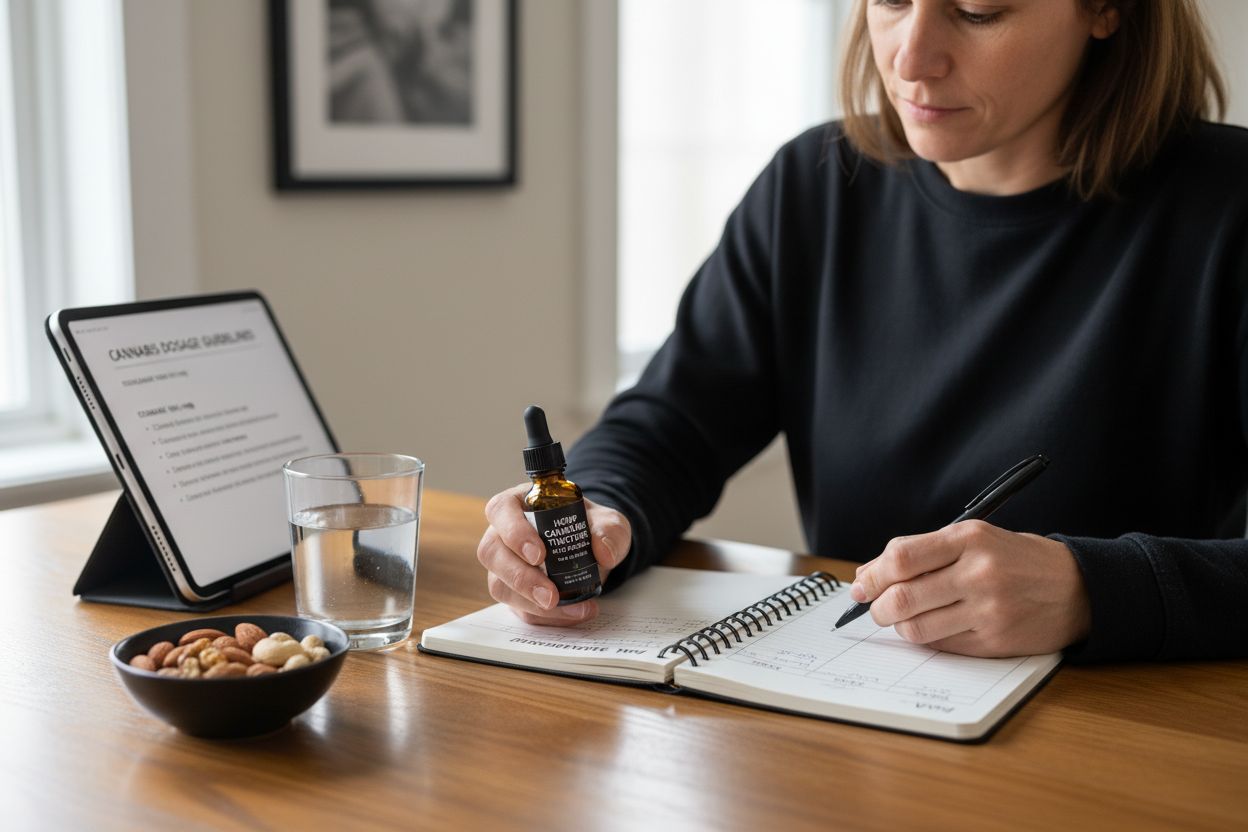How to Use Cannabis for Pain Relief Naturally
Written by Trevor

Did you know that over 50 million adults in the United States deal with chronic pain every year? For many, traditional treatments can fall short and the search for relief becomes exhausting. Exploring cannabis as a natural option has gained attention, but safe and informed use starts with a clear understanding of your unique pain profile and health needs. This guide offers a practical path for those curious about cannabis and looking for real solutions to manage discomfort.
Quick Summary
| Key Point | Explanation |
|---|---|
| 1. Track pain details in a journal | Document pain location, intensity, duration, and triggers to understand your health needs better. |
| 2. Consult healthcare professionals | Discuss your medical history with a professional to explore safe cannabis options for pain relief. |
| 3. Start with low cannabis doses | Begin with low doses and gradually adjust to find the effective amount for your individual response. |
| 4. Create a supportive environment | Ensure a comfortable and safe space to help enhance the therapeutic experience of cannabis use. |
| 5. Monitor effects and adjust accordingly | Actively track your response to cannabis and communicate regularly with healthcare providers to refine dosage. |
Table of Contents
- Step 1: Assess Your Pain and Health Needs
- Step 2: Select The Best Cannabis Product For Relief
- Step 3: Set Up A Safe And Supportive Environment
- Step 4: Administer Cannabis Following Best Practices
- Step 5: Monitor Effects And Adjust Dosage Responsibly
- Step 6: Verify Pain Relief And Record Your Experience
Step 1: Assess Your Pain and Health Needs
Understanding your pain and health requirements is the critical first step in determining whether cannabis might offer you natural relief. This section will guide you through a thoughtful self assessment process that helps you make an informed decision about potential cannabis based solutions.
Start by creating a comprehensive pain journal where you track specific details about your discomfort. Note the location of your pain, intensity levels using a 1 to 10 scale, duration, triggers, and how the pain impacts your daily activities. Are you experiencing chronic pain from an underlying condition like arthritis? Acute pain from an injury? Nerve related discomfort? Understanding these nuances matters.
Here’s a structured summary of what to track in your pain journal:
| Detail to Track | Example Entries | Purpose |
|---|---|---|
| Pain Location | Lower back Knees Shoulder |
Identifies affected area |
| Intensity (1-10) | 5 in morning 8 after activity |
Monitors severity and progress |
| Duration | 2 hours Persistent all day |
Tracks acute vs. chronic pain |
| Triggers | Lifting Weather changes Stress |
Reveals patterns and causes |
| Impact on Activities | Difficulty walking Trouble sleeping |
Assesses effect on daily life |
| Response to Treatments | Slight relief from ice No change |
Evaluates effectiveness |
According to an international medical guideline panel, patients with chronic cancer or non cancer pain might consider medical cannabis as a supplemental treatment option. However, this recommendation comes with important caveats. The research suggests small improvements in pain management, physical function, and sleep quality must be carefully balanced against potential transient side effects.
Consult with a healthcare professional who understands your medical history. They can help you evaluate whether cannabis might interact safely with existing medications and provide personalized guidance. Some medical conditions or prescription drugs could create contraindications you need to understand.
Pro Tip: Your pain journal becomes a powerful communication tool with medical professionals. The more specific and consistent your documentation, the better insights you can gain.
As you move forward, you will use this initial assessment to determine the most appropriate cannabis strain, consumption method, and potential dosage that might provide relief for your specific health needs.
Step 2: Select the Best Cannabis Product for Relief
Now that you understand your pain profile, it is time to explore cannabis products that can provide targeted relief. This step involves matching your specific health needs with the right cannabis formulation and consumption method.
Research shows that patients with chronic pain generally prefer cannabis products with balanced THC:CBD ratios or those with higher CBD content. These formulations tend to offer more therapeutic benefits with reduced psychoactive effects. When selecting a product, consider factors like administration method, cannabinoid profile, and potential interactions with your existing health conditions.
Oral administration methods are often recommended over inhaled products. This could mean tinctures, capsules, or oils that provide more consistent and controlled dosing. As an example, a comprehensive guide to choosing CBD hemp strains can help you understand the nuanced differences between various cannabis products.
Some patients find success with standardized extracts like Nabiximols an oromucosal spray containing both THC and CBD which is approved in some regions for specific pain conditions. However, availability and legal status vary, so consulting with a healthcare professional remains crucial.
Pro Tip: Always start with low doses and gradually adjust. Your body chemistry is unique and will respond differently to various cannabis formulations.
Consider practical aspects like cost, legal access, and potential addiction risks when making your selection. Your goal is finding a product that provides relief while minimizing potential side effects.
Step 3: Set Up a Safe and Supportive Environment
Creating a supportive and safe environment is crucial when exploring cannabis for pain relief. This step focuses on establishing physical and mental conditions that promote a positive and controlled healing experience.
According to clinical practice guidelines, setting up a safe environment involves more than just physical space it requires collaborative education and careful planning. Start by choosing a comfortable location where you feel secure and can relax without external stressors. This might be a quiet room in your home with soft lighting and comfortable seating.
Clinicians emphasize the importance of harm reduction and patient safety. This means being aware of potential side effects like dizziness, lethargy, or cognitive changes. Have a trusted friend or family member nearby who understands your treatment plan and can provide support if needed. Check out our guide to choosing hemp flower naturally for additional insights into responsible cannabis use.
Pro Tip: Keep a journal nearby to track your experiences, noting any side effects, dosage, and overall impact on your pain levels.
Ensure you have water, healthy snacks, and a safe place to rest. Remove any potential hazards from your immediate environment and have your phone or communication device within reach. Remember that everyone responds differently to cannabis, so patience and self awareness are key.
Avoid using cannabis during pregnancy, adolescence, or if you have certain medical conditions. Your goal is creating a supportive environment that promotes healing while minimizing potential risks.
Step 4: Administer Cannabis Following Best Practices
Administering cannabis effectively requires careful strategy and patient understanding. This step focuses on helping you develop a responsible and personalized approach to cannabis consumption that prioritizes your safety and therapeutic goals.
Clinical guidelines recommend a methodical approach to dosing. For non inhaled medical cannabis, experts suggest starting with low dose CBD approximately 5 mg taken twice daily. Gradually increase your dosage while carefully monitoring your body’s response. Learn more about understanding cannabis consumption methods to refine your approach.
When introducing THC into your regimen, begin with an ultra low dose of 1 to 2.5 mg per day. Professional medical recommendations indicate you can slowly titrate up to about 40 mg per day while balancing potential therapeutic benefits against possible side effects. This slow and steady approach allows your body to adjust and helps you identify the minimum effective dose.
![]()
Pro Tip: Keep a detailed journal tracking your dosage, timing, product type, and how you feel. This documentation becomes an invaluable tool for understanding your unique response.
Consider your specific health conditions when selecting administration routes. Some patients might benefit from oral tinctures, while others may prefer capsules or topical applications. Always prioritize methods that provide consistent and controlled dosing.
Remember that individual responses vary widely.
 What works for one person might not work identically for another. Patience, self awareness, and open communication with healthcare professionals are key to finding your optimal cannabis therapy strategy.
What works for one person might not work identically for another. Patience, self awareness, and open communication with healthcare professionals are key to finding your optimal cannabis therapy strategy.
Step 5: Monitor Effects and Adjust Dosage Responsibly
Monitoring your cannabis therapy is a critical process that requires active engagement and careful observation. This step focuses on helping you track your progress, understand your body’s response, and make informed adjustments to your treatment plan.
Medical research emphasizes the importance of ongoing monitoring. The benefits of cannabis can be subtle and closely balanced, which means you need to pay attention to multiple aspects of your experience. Learn more about microdosing cannabis flower for enhanced wellness to understand nuanced tracking methods.
Track key indicators including pain relief intensity, physical functioning, sleep quality, and any potential side effects. Create a consistent log where you document your dosage, timing, product type, and most importantly how you feel physically and mentally. Note changes in pain levels, energy, mood, and any unexpected reactions.
Pro Tip: Use a simple rating system in your journal. For example rate pain on a 1 to 10 scale before and after cannabis use to objectively measure improvements.
Collaborative adjustment is key. This means regular check ins with your healthcare provider to discuss your experiences. They can help you interpret your logs and make scientifically informed dosage modifications. Remember that everyone responds differently to cannabis therapies.
Be patient with yourself. Finding the right balance takes time and careful observation. Your goal is discovering a personalized approach that provides maximum relief with minimal side effects.
Step 6: Verify Pain Relief and Record Your Experience
Verifying pain relief is a nuanced process that requires systematic observation and honest self reflection. This step transforms your cannabis therapy from a guessing game to a data driven approach for understanding your body’s response.
Clinical recommendations emphasize maintaining detailed documentation of your treatment journey. Discover the best pain relief cannabis strains for natural relief to complement your record keeping strategy and understand potential variability in strain effectiveness.
Create a comprehensive tracking system that goes beyond simple pain ratings. Document not just pain intensity but also its character depth location and how it impacts your daily functioning. Note the time of day symptoms change physical activities you can now perform and emotional shifts that accompany pain reduction.
Pro Tip: Use a consistent digital or physical template to ensure you capture the same information each time. Consistency is key in generating meaningful insights.
Be objective and specific in your recordings. Instead of writing general statements like feeling better track precise changes such as increased range of motion reduced muscle tension or improved sleep quality. This granular approach provides your healthcare provider with actionable information for potential treatment refinements.
Remember that healing is not linear. Some days will show more improvement than others. Your goal is understanding your unique response pattern and building a personalized approach to pain management.
Experience Reliable Natural Pain Relief with California Blendz
Are you searching for a genuine way to manage pain naturally and looking for cannabis options that are transparent, safe, and tailored to your needs? Your pain journey and quest for the right cannabis product do not need to be overwhelming. California Blendz removes the guesswork by delivering lab-tested hemp-derived CBD and THCa flower grown organically in California’s Emerald Triangle. If terms like “pain journal,” “careful dosing,” and “verified relief” resonate with your path from the article, you can now apply these best practices using our curated The THCa Prestige Vault selection. Each flower and pre-roll in our store is chosen for quality, effect, and transparency, helping you find relief without uncertainty.

Step into a new era of natural wellness. Shop California Blendz now for trustworthy products that support your daily documentation, responsible adjustments, and safe experiences as outlined in your pain management plan. Ready to move from research to safe, effective relaxation and relief? Begin with The THCa Prestige Vault or explore our Founder’s Collection for premium bundles. Take control of your pain relief journey with a retailer who cares about your health goals and experience.
Frequently Asked Questions
How can I assess my pain levels before using cannabis for relief?
To assess your pain levels, start by creating a pain journal. Track specific details like pain location, intensity on a scale from 1 to 10, duration, triggers, and how it impacts your daily activities. This information will help inform your choice of cannabis products.
What cannabis products are best for managing pain naturally?
Products with a balanced THC:CBD ratio or higher CBD content are often recommended for pain relief. Explore options like tinctures, capsules, and oils for oral administration as these provide more consistent dosing and therapeutic benefits without strong psychoactive effects.
How should I create a safe environment for using cannabis?
To create a safe environment, choose a comfortable, quiet space where you feel secure while using cannabis. Ensure you have necessary supplies like water and healthy snacks, and consider having a trusted friend nearby to support you in case you experience any side effects.
What is the best way to start dosing cannabis for pain?
Begin with a low dose, such as 5 mg of CBD taken twice daily, and gradually increase based on your body’s response. Document your dosage and effects in your pain journal to find the minimum effective dose that helps alleviate your pain.
How can I track the effects of cannabis on my pain management?
Monitor your cannabis therapy by keeping a detailed log of your pain levels, sleep quality, activity levels, and any side effects you experience. Use a simple rating system, like a scale from 1 to 10, to objectively assess changes before and after using cannabis for pain relief.
What should I do if I don’t experience pain relief with cannabis?
If cannabis does not provide relief, review your pain journal to identify patterns and discuss them with your healthcare provider. They can help adjust your dosage or recommend alternative strains or consumption methods tailored to your specific pain management needs.








